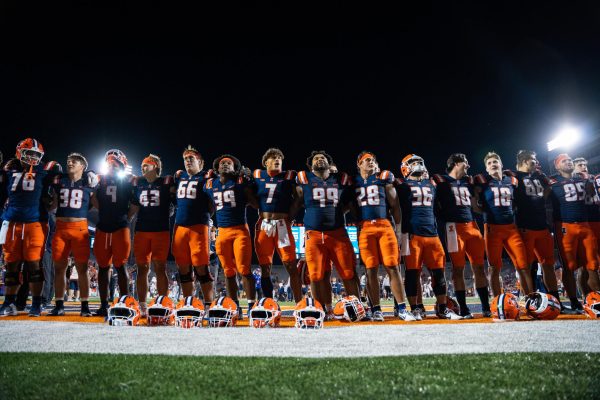Engineering without Borders works to impact the world
Feb 9, 2018
Last updated on March 11, 2018 at 10:14 a.m.
A big part of college is learning about the problems that exist all around the world and trying to come up with solutions. Then comes the realization that the world is very big, and every problem is very complex. It is easy to become disheartened, to feel intimidated into inaction, but there are still ways to help. Here at the University, one of the ways that students are making an impact is through Engineers without Borders (EWB).
Gathering the individual efforts of students to create real change requires oversight, but more importantly, it requires organization. Dinaz Kureishy, sophomore in Engineering, serves as the University’s EWB chapter president.
“Here at UIUC, we are working on projects that deal with water, electricity and bridges, to name a few,” Kureishy said. “We execute everything from planning and fundraising for trips to designing and implementing our solutions. As students, I think that is pretty incredible.”
EWB’s efforts to bring real and lasting improvements to people who need it through innovation is what drives the projects that Kureishy talks about. A moving example of these efforts is the Chilaweni Bridge Project.
Get The Daily Illini in your inbox!
Jack Hynes, senior in Engineering, serves as one of the leads for the project. Hynes explained that the Chilaweni community is located in the eastern African country of Malawi. About 20,000 people are often left without access to nearby urban centers when the usual routes they travel on become unavailable. During the wet season, this can often occur for months at a time.
To solve this problem, the Chilaweni Bridge Project is designing and overseeing the funding and construction of a series of bridges within the Chilaweni community. With their construction, these bridges will bring consistent schooling to children, the opportunity to sell their crops to farmers and medical care to the sick.
In short, the project is going to help people. Due to the efforts of the students in EWB, these people will have a better standard of life.
To do projects like this one, though, EWB uses the skills of all its members, each part of the team having a different role to play. The project has three parts, overseen by the team leaders. Project development and community outreach handles the public awareness of the EWB project within the University, while the fundraising committee works to keep the project funded to ultimately reach its end goal.
On the engineering side of the project, design and construction members handle some of the more technical aspects. They innovate new ideas and find the most efficient solution to the project at hand, often with the help of professors. This can come with advice from industry leaders based either in Champaign-Urbana or in Chicago, who can provide the advice necessary to get the project from a hopeful dream to a real-world benefit.
The other project leader of the Chilaweni Bridge Project is Lucy Dunderman, senior in ACES. Dunderman said there is a trickle effect at play: what the project is doing is saving lives, and those people have the ability to help make their own world better.
“If you’re just changing one person’s life, for them you’re changing the world,” Dunderman said.
Another EWB initiative is the Nepal Project. In a mountainous area with frequent earthquakes like Nepal, buildings that are not built to spec can quickly be spotted. The project addresses the need for a stable structure that can serve a community’s need, according to Jake Feiger, junior in Engineering.
“In a building’s corner…you’ll see a lot of exposed brick or wood, where the walls have been shaken against one another,” Feiger said.
The Chilaweni community needs a building with as much stability as possible, which, in this case, is a school. At high altitudes, the small size, metal roofing and lack of internal plumbing in their Temporary Learning Center contributes to a building that’s hot in the summer, cold in the winter and overall, unsuitable for the education of children.
A new building constructed with the limitations of the area in mind would drastically improve the community’s ability to educate its children, allowing them to take more skilled jobs than their parents.
Thinking back on the trip that he and other project members took to visit the village, Feiger remembered that many of the children wished to be pilots when they were older, because seeing helicopters and planes in the sky would be their reminders of the wider world.
Trying to change the world is admirable, but it takes fortitude, commitment and organization to make any kind of meaningful progress. Here at the University, though, the students working in Engineers Without Borders are demonstrating that anyone can make the world a better place, one corner at a time.






